Importance of Patient Advocacy in Nursing: A Case Study Report
VerifiedAdded on 2020/02/03
|19
|7674
|53
Report
AI Summary
This report critically examines the concept of advocacy in nursing, emphasizing its significance in healthcare settings. It uses a case study of a 7-year-old child with a learning disability and ADHD to illustrate the practical application of advocacy. The report explores social, ethical, legal, organizational, and cultural aspects related to advocacy, highlighting the role of nurses in supporting patients' rights and well-being. It addresses factors that both support and limit advocacy, and discusses strategies to overcome barriers. The report also delves into the challenges nurses face in creating an organizational culture that prioritizes advocacy, and concludes with a summary of key findings and recommendations for improving patient care through effective advocacy practices. The analysis emphasizes the importance of ethical considerations, confidentiality, and the legal rights of patients, particularly children with special needs. The report underscores the need for nurses to act as advocates, ensuring patients receive appropriate support and assistance within the healthcare system.

TOTAL WORD COUNT = 5,264 WORDS.
1
1
Paraphrase This Document
Need a fresh take? Get an instant paraphrase of this document with our AI Paraphraser
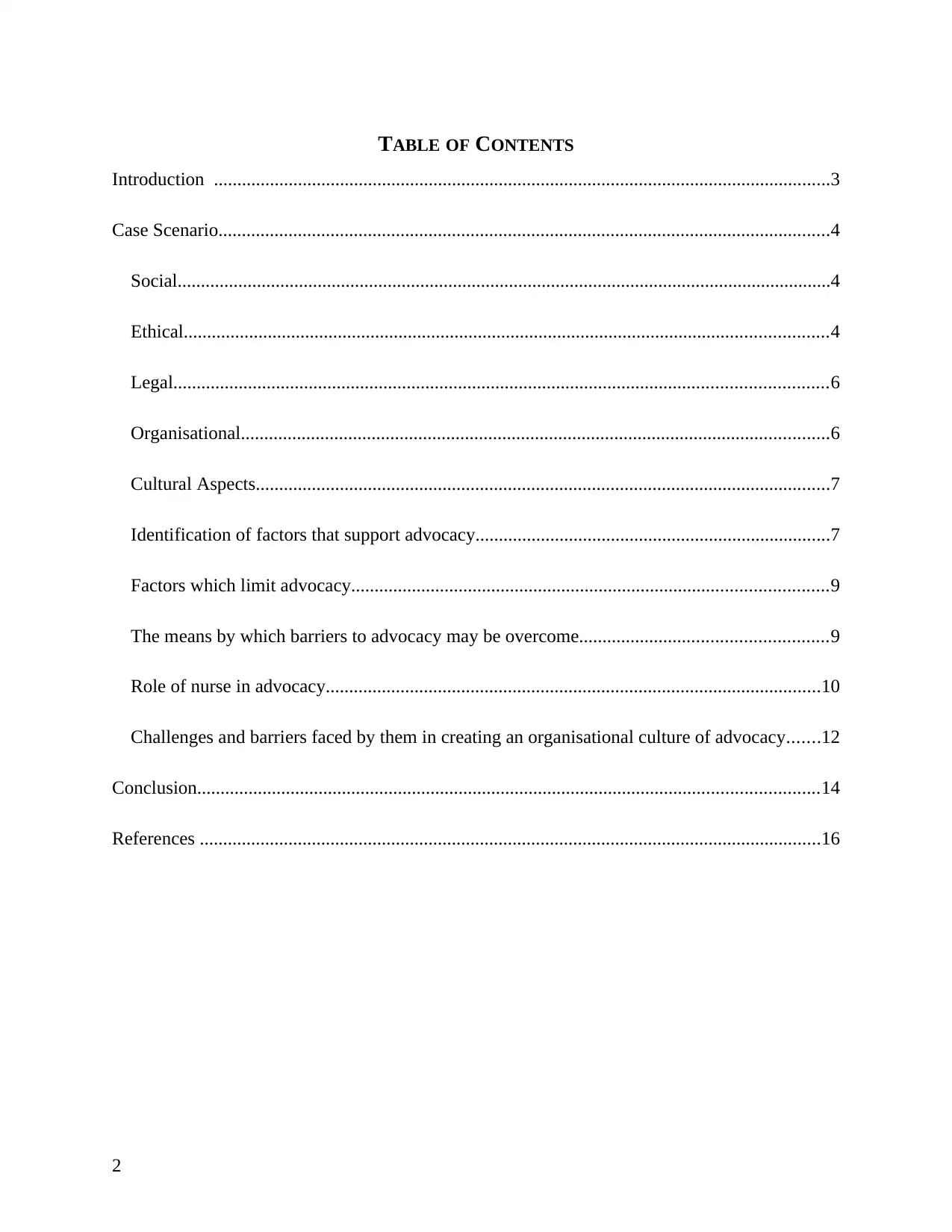
TABLE OF CONTENTS
Introduction ....................................................................................................................................3
Case Scenario...................................................................................................................................4
Social............................................................................................................................................4
Ethical..........................................................................................................................................4
Legal............................................................................................................................................6
Organisational..............................................................................................................................6
Cultural Aspects...........................................................................................................................7
Identification of factors that support advocacy............................................................................7
Factors which limit advocacy......................................................................................................9
The means by which barriers to advocacy may be overcome.....................................................9
Role of nurse in advocacy..........................................................................................................10
Challenges and barriers faced by them in creating an organisational culture of advocacy.......12
Conclusion.....................................................................................................................................14
References .....................................................................................................................................16
2
Introduction ....................................................................................................................................3
Case Scenario...................................................................................................................................4
Social............................................................................................................................................4
Ethical..........................................................................................................................................4
Legal............................................................................................................................................6
Organisational..............................................................................................................................6
Cultural Aspects...........................................................................................................................7
Identification of factors that support advocacy............................................................................7
Factors which limit advocacy......................................................................................................9
The means by which barriers to advocacy may be overcome.....................................................9
Role of nurse in advocacy..........................................................................................................10
Challenges and barriers faced by them in creating an organisational culture of advocacy.......12
Conclusion.....................................................................................................................................14
References .....................................................................................................................................16
2
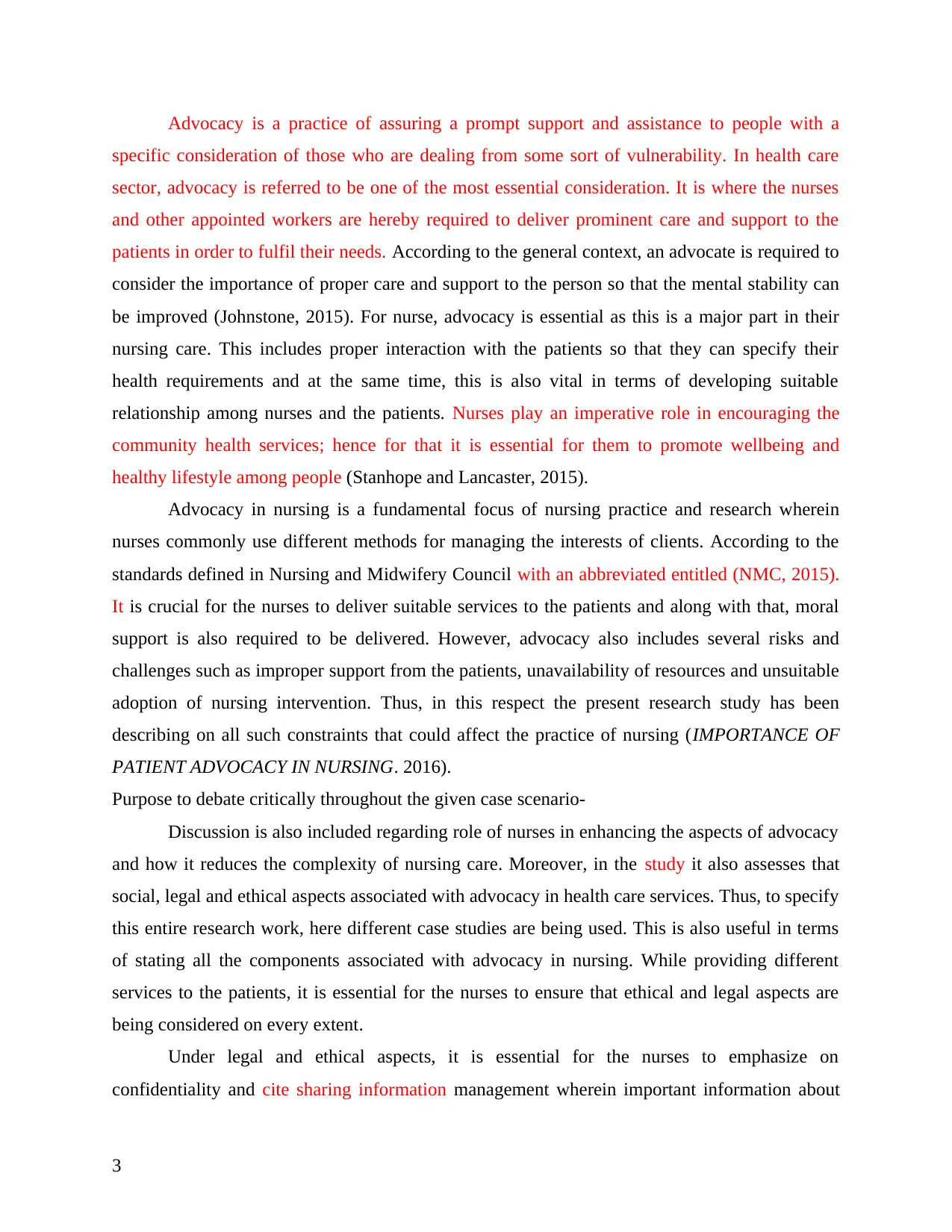
Advocacy is a practice of assuring a prompt support and assistance to people with a
specific consideration of those who are dealing from some sort of vulnerability. In health care
sector, advocacy is referred to be one of the most essential consideration. It is where the nurses
and other appointed workers are hereby required to deliver prominent care and support to the
patients in order to fulfil their needs. According to the general context, an advocate is required to
consider the importance of proper care and support to the person so that the mental stability can
be improved (Johnstone, 2015). For nurse, advocacy is essential as this is a major part in their
nursing care. This includes proper interaction with the patients so that they can specify their
health requirements and at the same time, this is also vital in terms of developing suitable
relationship among nurses and the patients. Nurses play an imperative role in encouraging the
community health services; hence for that it is essential for them to promote wellbeing and
healthy lifestyle among people (Stanhope and Lancaster, 2015).
Advocacy in nursing is a fundamental focus of nursing practice and research wherein
nurses commonly use different methods for managing the interests of clients. According to the
standards defined in Nursing and Midwifery Council with an abbreviated entitled (NMC, 2015).
It is crucial for the nurses to deliver suitable services to the patients and along with that, moral
support is also required to be delivered. However, advocacy also includes several risks and
challenges such as improper support from the patients, unavailability of resources and unsuitable
adoption of nursing intervention. Thus, in this respect the present research study has been
describing on all such constraints that could affect the practice of nursing (IMPORTANCE OF
PATIENT ADVOCACY IN NURSING. 2016).
Purpose to debate critically throughout the given case scenario-
Discussion is also included regarding role of nurses in enhancing the aspects of advocacy
and how it reduces the complexity of nursing care. Moreover, in the study it also assesses that
social, legal and ethical aspects associated with advocacy in health care services. Thus, to specify
this entire research work, here different case studies are being used. This is also useful in terms
of stating all the components associated with advocacy in nursing. While providing different
services to the patients, it is essential for the nurses to ensure that ethical and legal aspects are
being considered on every extent.
Under legal and ethical aspects, it is essential for the nurses to emphasize on
confidentiality and cite sharing information management wherein important information about
3
specific consideration of those who are dealing from some sort of vulnerability. In health care
sector, advocacy is referred to be one of the most essential consideration. It is where the nurses
and other appointed workers are hereby required to deliver prominent care and support to the
patients in order to fulfil their needs. According to the general context, an advocate is required to
consider the importance of proper care and support to the person so that the mental stability can
be improved (Johnstone, 2015). For nurse, advocacy is essential as this is a major part in their
nursing care. This includes proper interaction with the patients so that they can specify their
health requirements and at the same time, this is also vital in terms of developing suitable
relationship among nurses and the patients. Nurses play an imperative role in encouraging the
community health services; hence for that it is essential for them to promote wellbeing and
healthy lifestyle among people (Stanhope and Lancaster, 2015).
Advocacy in nursing is a fundamental focus of nursing practice and research wherein
nurses commonly use different methods for managing the interests of clients. According to the
standards defined in Nursing and Midwifery Council with an abbreviated entitled (NMC, 2015).
It is crucial for the nurses to deliver suitable services to the patients and along with that, moral
support is also required to be delivered. However, advocacy also includes several risks and
challenges such as improper support from the patients, unavailability of resources and unsuitable
adoption of nursing intervention. Thus, in this respect the present research study has been
describing on all such constraints that could affect the practice of nursing (IMPORTANCE OF
PATIENT ADVOCACY IN NURSING. 2016).
Purpose to debate critically throughout the given case scenario-
Discussion is also included regarding role of nurses in enhancing the aspects of advocacy
and how it reduces the complexity of nursing care. Moreover, in the study it also assesses that
social, legal and ethical aspects associated with advocacy in health care services. Thus, to specify
this entire research work, here different case studies are being used. This is also useful in terms
of stating all the components associated with advocacy in nursing. While providing different
services to the patients, it is essential for the nurses to ensure that ethical and legal aspects are
being considered on every extent.
Under legal and ethical aspects, it is essential for the nurses to emphasize on
confidentiality and cite sharing information management wherein important information about
3
⊘ This is a preview!⊘
Do you want full access?
Subscribe today to unlock all pages.

Trusted by 1+ million students worldwide
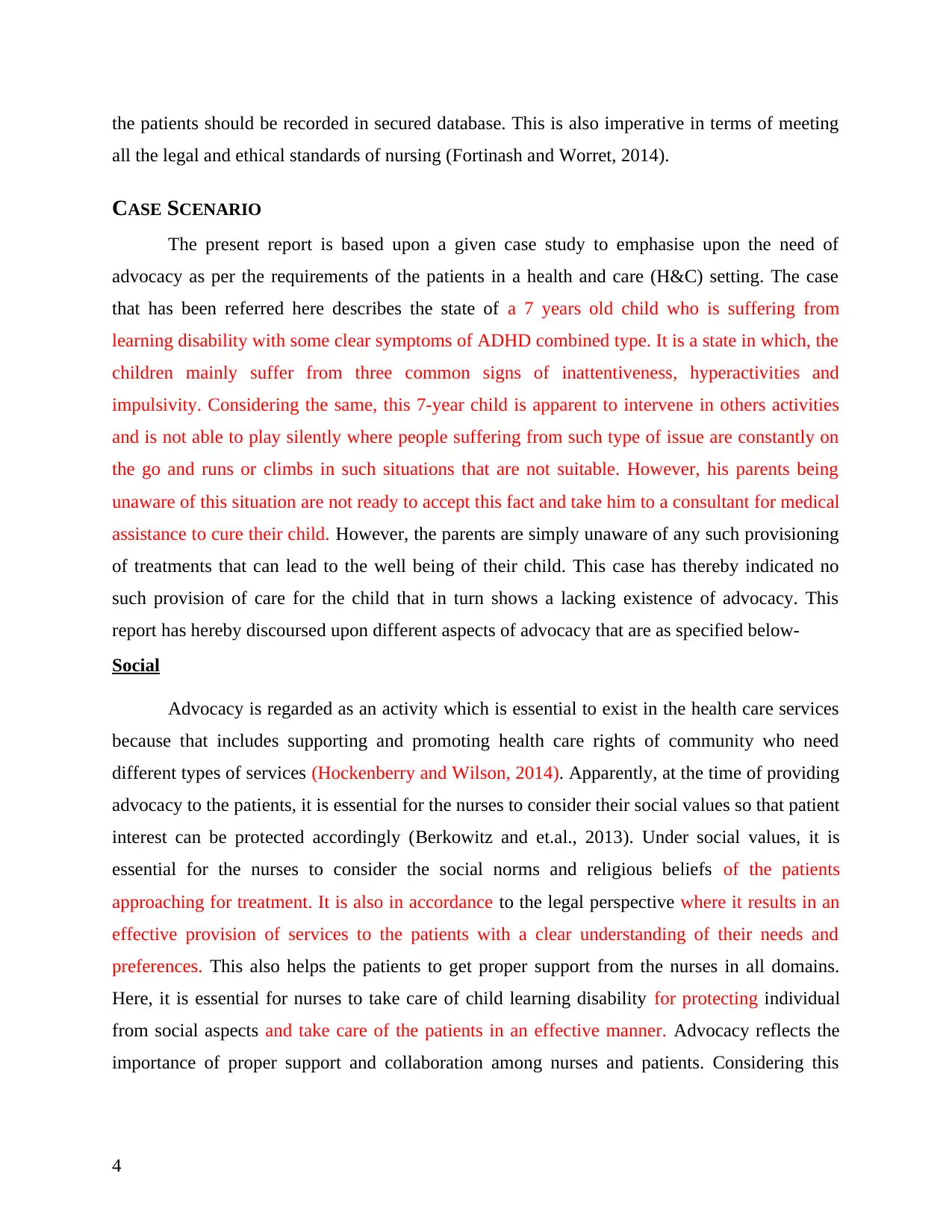
the patients should be recorded in secured database. This is also imperative in terms of meeting
all the legal and ethical standards of nursing (Fortinash and Worret, 2014).
CASE SCENARIO
The present report is based upon a given case study to emphasise upon the need of
advocacy as per the requirements of the patients in a health and care (H&C) setting. The case
that has been referred here describes the state of a 7 years old child who is suffering from
learning disability with some clear symptoms of ADHD combined type. It is a state in which, the
children mainly suffer from three common signs of inattentiveness, hyperactivities and
impulsivity. Considering the same, this 7-year child is apparent to intervene in others activities
and is not able to play silently where people suffering from such type of issue are constantly on
the go and runs or climbs in such situations that are not suitable. However, his parents being
unaware of this situation are not ready to accept this fact and take him to a consultant for medical
assistance to cure their child. However, the parents are simply unaware of any such provisioning
of treatments that can lead to the well being of their child. This case has thereby indicated no
such provision of care for the child that in turn shows a lacking existence of advocacy. This
report has hereby discoursed upon different aspects of advocacy that are as specified below-
Social
Advocacy is regarded as an activity which is essential to exist in the health care services
because that includes supporting and promoting health care rights of community who need
different types of services (Hockenberry and Wilson, 2014). Apparently, at the time of providing
advocacy to the patients, it is essential for the nurses to consider their social values so that patient
interest can be protected accordingly (Berkowitz and et.al., 2013). Under social values, it is
essential for the nurses to consider the social norms and religious beliefs of the patients
approaching for treatment. It is also in accordance to the legal perspective where it results in an
effective provision of services to the patients with a clear understanding of their needs and
preferences. This also helps the patients to get proper support from the nurses in all domains.
Here, it is essential for nurses to take care of child learning disability for protecting individual
from social aspects and take care of the patients in an effective manner. Advocacy reflects the
importance of proper support and collaboration among nurses and patients. Considering this
4
all the legal and ethical standards of nursing (Fortinash and Worret, 2014).
CASE SCENARIO
The present report is based upon a given case study to emphasise upon the need of
advocacy as per the requirements of the patients in a health and care (H&C) setting. The case
that has been referred here describes the state of a 7 years old child who is suffering from
learning disability with some clear symptoms of ADHD combined type. It is a state in which, the
children mainly suffer from three common signs of inattentiveness, hyperactivities and
impulsivity. Considering the same, this 7-year child is apparent to intervene in others activities
and is not able to play silently where people suffering from such type of issue are constantly on
the go and runs or climbs in such situations that are not suitable. However, his parents being
unaware of this situation are not ready to accept this fact and take him to a consultant for medical
assistance to cure their child. However, the parents are simply unaware of any such provisioning
of treatments that can lead to the well being of their child. This case has thereby indicated no
such provision of care for the child that in turn shows a lacking existence of advocacy. This
report has hereby discoursed upon different aspects of advocacy that are as specified below-
Social
Advocacy is regarded as an activity which is essential to exist in the health care services
because that includes supporting and promoting health care rights of community who need
different types of services (Hockenberry and Wilson, 2014). Apparently, at the time of providing
advocacy to the patients, it is essential for the nurses to consider their social values so that patient
interest can be protected accordingly (Berkowitz and et.al., 2013). Under social values, it is
essential for the nurses to consider the social norms and religious beliefs of the patients
approaching for treatment. It is also in accordance to the legal perspective where it results in an
effective provision of services to the patients with a clear understanding of their needs and
preferences. This also helps the patients to get proper support from the nurses in all domains.
Here, it is essential for nurses to take care of child learning disability for protecting individual
from social aspects and take care of the patients in an effective manner. Advocacy reflects the
importance of proper support and collaboration among nurses and patients. Considering this
4
Paraphrase This Document
Need a fresh take? Get an instant paraphrase of this document with our AI Paraphraser
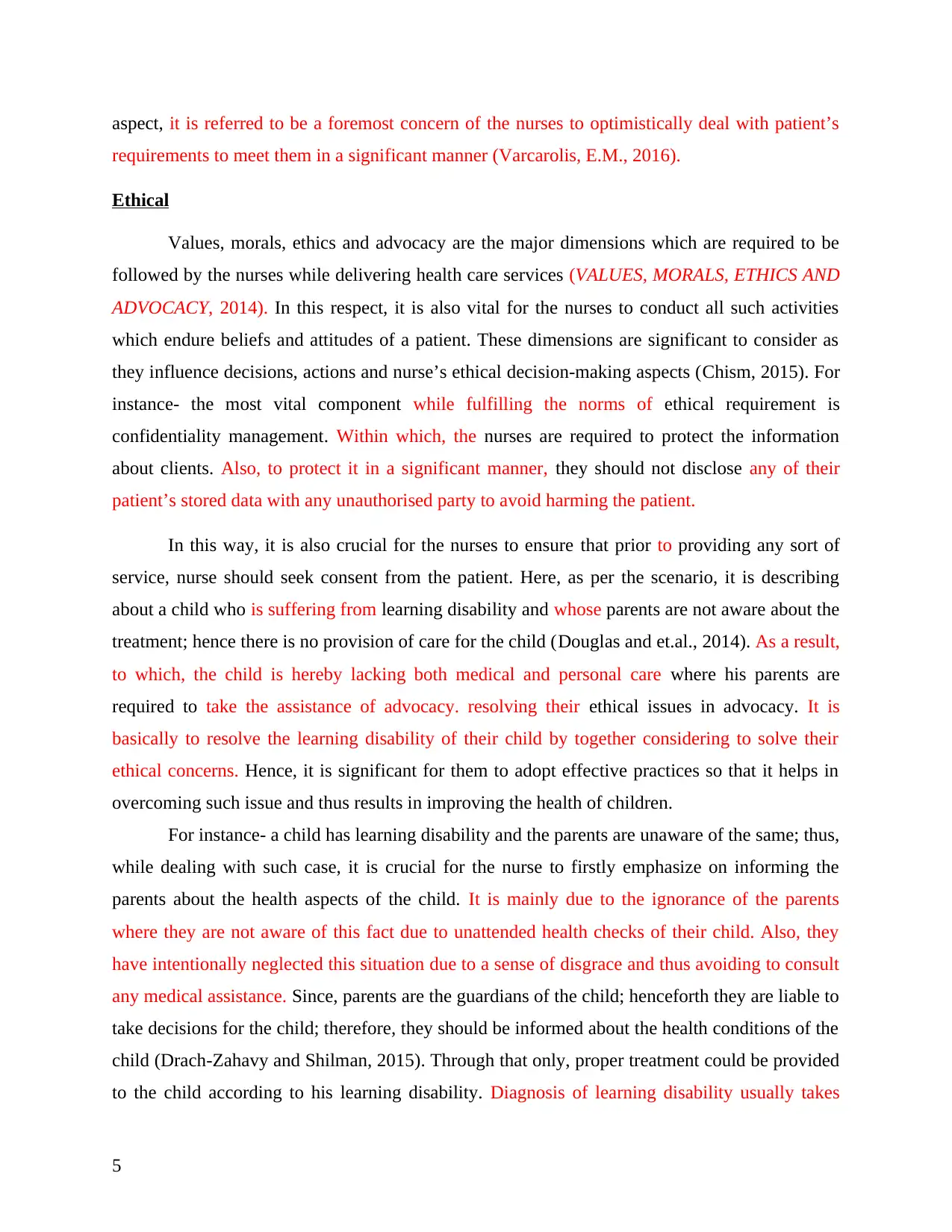
aspect, it is referred to be a foremost concern of the nurses to optimistically deal with patient’s
requirements to meet them in a significant manner (Varcarolis, E.M., 2016).
Ethical
Values, morals, ethics and advocacy are the major dimensions which are required to be
followed by the nurses while delivering health care services (VALUES, MORALS, ETHICS AND
ADVOCACY, 2014). In this respect, it is also vital for the nurses to conduct all such activities
which endure beliefs and attitudes of a patient. These dimensions are significant to consider as
they influence decisions, actions and nurse’s ethical decision-making aspects (Chism, 2015). For
instance- the most vital component while fulfilling the norms of ethical requirement is
confidentiality management. Within which, the nurses are required to protect the information
about clients. Also, to protect it in a significant manner, they should not disclose any of their
patient’s stored data with any unauthorised party to avoid harming the patient.
In this way, it is also crucial for the nurses to ensure that prior to providing any sort of
service, nurse should seek consent from the patient. Here, as per the scenario, it is describing
about a child who is suffering from learning disability and whose parents are not aware about the
treatment; hence there is no provision of care for the child (Douglas and et.al., 2014). As a result,
to which, the child is hereby lacking both medical and personal care where his parents are
required to take the assistance of advocacy. resolving their ethical issues in advocacy. It is
basically to resolve the learning disability of their child by together considering to solve their
ethical concerns. Hence, it is significant for them to adopt effective practices so that it helps in
overcoming such issue and thus results in improving the health of children.
For instance- a child has learning disability and the parents are unaware of the same; thus,
while dealing with such case, it is crucial for the nurse to firstly emphasize on informing the
parents about the health aspects of the child. It is mainly due to the ignorance of the parents
where they are not aware of this fact due to unattended health checks of their child. Also, they
have intentionally neglected this situation due to a sense of disgrace and thus avoiding to consult
any medical assistance. Since, parents are the guardians of the child; henceforth they are liable to
take decisions for the child; therefore, they should be informed about the health conditions of the
child (Drach‐Zahavy and Shilman, 2015). Through that only, proper treatment could be provided
to the child according to his learning disability. Diagnosis of learning disability usually takes
5
requirements to meet them in a significant manner (Varcarolis, E.M., 2016).
Ethical
Values, morals, ethics and advocacy are the major dimensions which are required to be
followed by the nurses while delivering health care services (VALUES, MORALS, ETHICS AND
ADVOCACY, 2014). In this respect, it is also vital for the nurses to conduct all such activities
which endure beliefs and attitudes of a patient. These dimensions are significant to consider as
they influence decisions, actions and nurse’s ethical decision-making aspects (Chism, 2015). For
instance- the most vital component while fulfilling the norms of ethical requirement is
confidentiality management. Within which, the nurses are required to protect the information
about clients. Also, to protect it in a significant manner, they should not disclose any of their
patient’s stored data with any unauthorised party to avoid harming the patient.
In this way, it is also crucial for the nurses to ensure that prior to providing any sort of
service, nurse should seek consent from the patient. Here, as per the scenario, it is describing
about a child who is suffering from learning disability and whose parents are not aware about the
treatment; hence there is no provision of care for the child (Douglas and et.al., 2014). As a result,
to which, the child is hereby lacking both medical and personal care where his parents are
required to take the assistance of advocacy. resolving their ethical issues in advocacy. It is
basically to resolve the learning disability of their child by together considering to solve their
ethical concerns. Hence, it is significant for them to adopt effective practices so that it helps in
overcoming such issue and thus results in improving the health of children.
For instance- a child has learning disability and the parents are unaware of the same; thus,
while dealing with such case, it is crucial for the nurse to firstly emphasize on informing the
parents about the health aspects of the child. It is mainly due to the ignorance of the parents
where they are not aware of this fact due to unattended health checks of their child. Also, they
have intentionally neglected this situation due to a sense of disgrace and thus avoiding to consult
any medical assistance. Since, parents are the guardians of the child; henceforth they are liable to
take decisions for the child; therefore, they should be informed about the health conditions of the
child (Drach‐Zahavy and Shilman, 2015). Through that only, proper treatment could be provided
to the child according to his learning disability. Diagnosis of learning disability usually takes
5
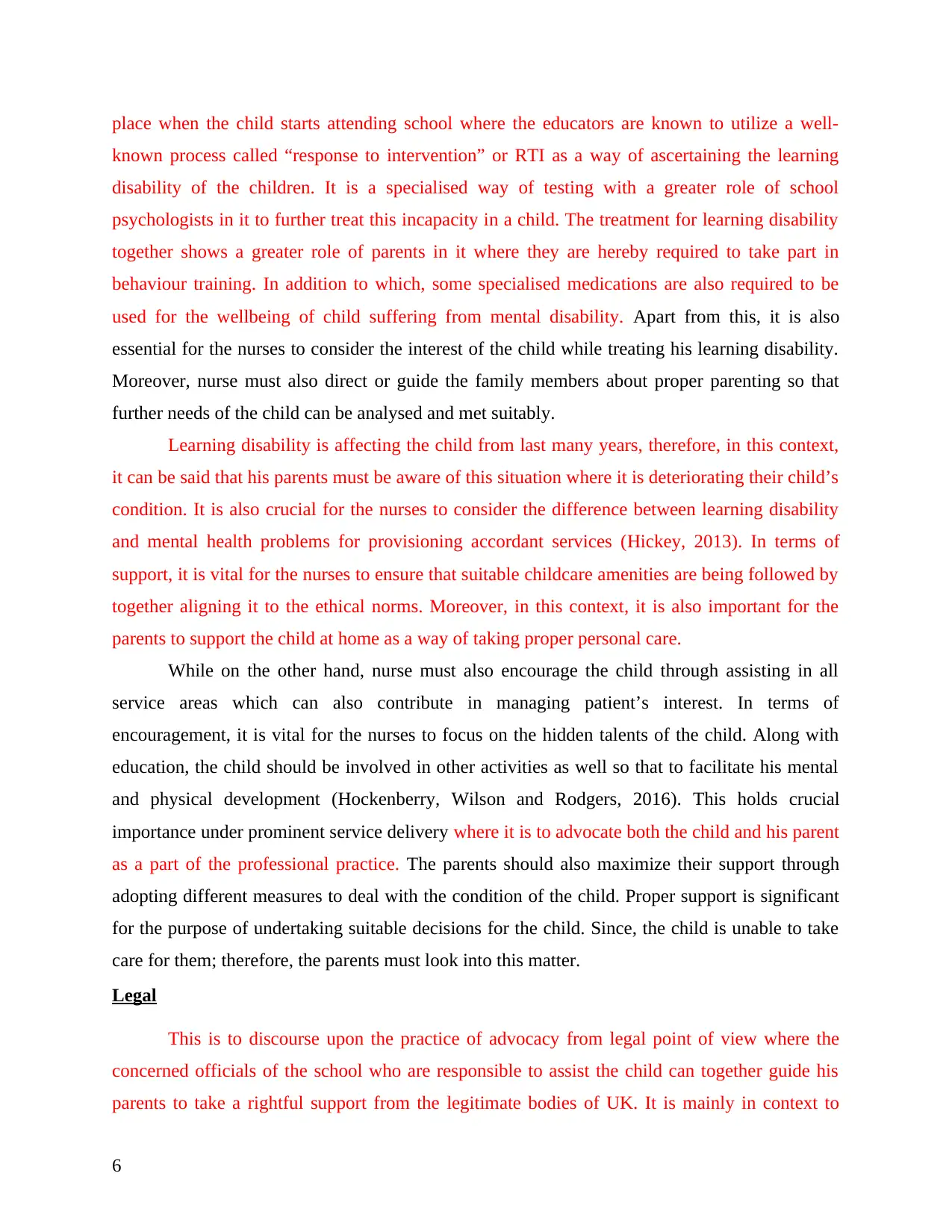
place when the child starts attending school where the educators are known to utilize a well-
known process called “response to intervention” or RTI as a way of ascertaining the learning
disability of the children. It is a specialised way of testing with a greater role of school
psychologists in it to further treat this incapacity in a child. The treatment for learning disability
together shows a greater role of parents in it where they are hereby required to take part in
behaviour training. In addition to which, some specialised medications are also required to be
used for the wellbeing of child suffering from mental disability. Apart from this, it is also
essential for the nurses to consider the interest of the child while treating his learning disability.
Moreover, nurse must also direct or guide the family members about proper parenting so that
further needs of the child can be analysed and met suitably.
Learning disability is affecting the child from last many years, therefore, in this context,
it can be said that his parents must be aware of this situation where it is deteriorating their child’s
condition. It is also crucial for the nurses to consider the difference between learning disability
and mental health problems for provisioning accordant services (Hickey, 2013). In terms of
support, it is vital for the nurses to ensure that suitable childcare amenities are being followed by
together aligning it to the ethical norms. Moreover, in this context, it is also important for the
parents to support the child at home as a way of taking proper personal care.
While on the other hand, nurse must also encourage the child through assisting in all
service areas which can also contribute in managing patient’s interest. In terms of
encouragement, it is vital for the nurses to focus on the hidden talents of the child. Along with
education, the child should be involved in other activities as well so that to facilitate his mental
and physical development (Hockenberry, Wilson and Rodgers, 2016). This holds crucial
importance under prominent service delivery where it is to advocate both the child and his parent
as a part of the professional practice. The parents should also maximize their support through
adopting different measures to deal with the condition of the child. Proper support is significant
for the purpose of undertaking suitable decisions for the child. Since, the child is unable to take
care for them; therefore, the parents must look into this matter.
Legal
This is to discourse upon the practice of advocacy from legal point of view where the
concerned officials of the school who are responsible to assist the child can together guide his
parents to take a rightful support from the legitimate bodies of UK. It is mainly in context to
6
known process called “response to intervention” or RTI as a way of ascertaining the learning
disability of the children. It is a specialised way of testing with a greater role of school
psychologists in it to further treat this incapacity in a child. The treatment for learning disability
together shows a greater role of parents in it where they are hereby required to take part in
behaviour training. In addition to which, some specialised medications are also required to be
used for the wellbeing of child suffering from mental disability. Apart from this, it is also
essential for the nurses to consider the interest of the child while treating his learning disability.
Moreover, nurse must also direct or guide the family members about proper parenting so that
further needs of the child can be analysed and met suitably.
Learning disability is affecting the child from last many years, therefore, in this context,
it can be said that his parents must be aware of this situation where it is deteriorating their child’s
condition. It is also crucial for the nurses to consider the difference between learning disability
and mental health problems for provisioning accordant services (Hickey, 2013). In terms of
support, it is vital for the nurses to ensure that suitable childcare amenities are being followed by
together aligning it to the ethical norms. Moreover, in this context, it is also important for the
parents to support the child at home as a way of taking proper personal care.
While on the other hand, nurse must also encourage the child through assisting in all
service areas which can also contribute in managing patient’s interest. In terms of
encouragement, it is vital for the nurses to focus on the hidden talents of the child. Along with
education, the child should be involved in other activities as well so that to facilitate his mental
and physical development (Hockenberry, Wilson and Rodgers, 2016). This holds crucial
importance under prominent service delivery where it is to advocate both the child and his parent
as a part of the professional practice. The parents should also maximize their support through
adopting different measures to deal with the condition of the child. Proper support is significant
for the purpose of undertaking suitable decisions for the child. Since, the child is unable to take
care for them; therefore, the parents must look into this matter.
Legal
This is to discourse upon the practice of advocacy from legal point of view where the
concerned officials of the school who are responsible to assist the child can together guide his
parents to take a rightful support from the legitimate bodies of UK. It is mainly in context to
6
⊘ This is a preview!⊘
Do you want full access?
Subscribe today to unlock all pages.

Trusted by 1+ million students worldwide
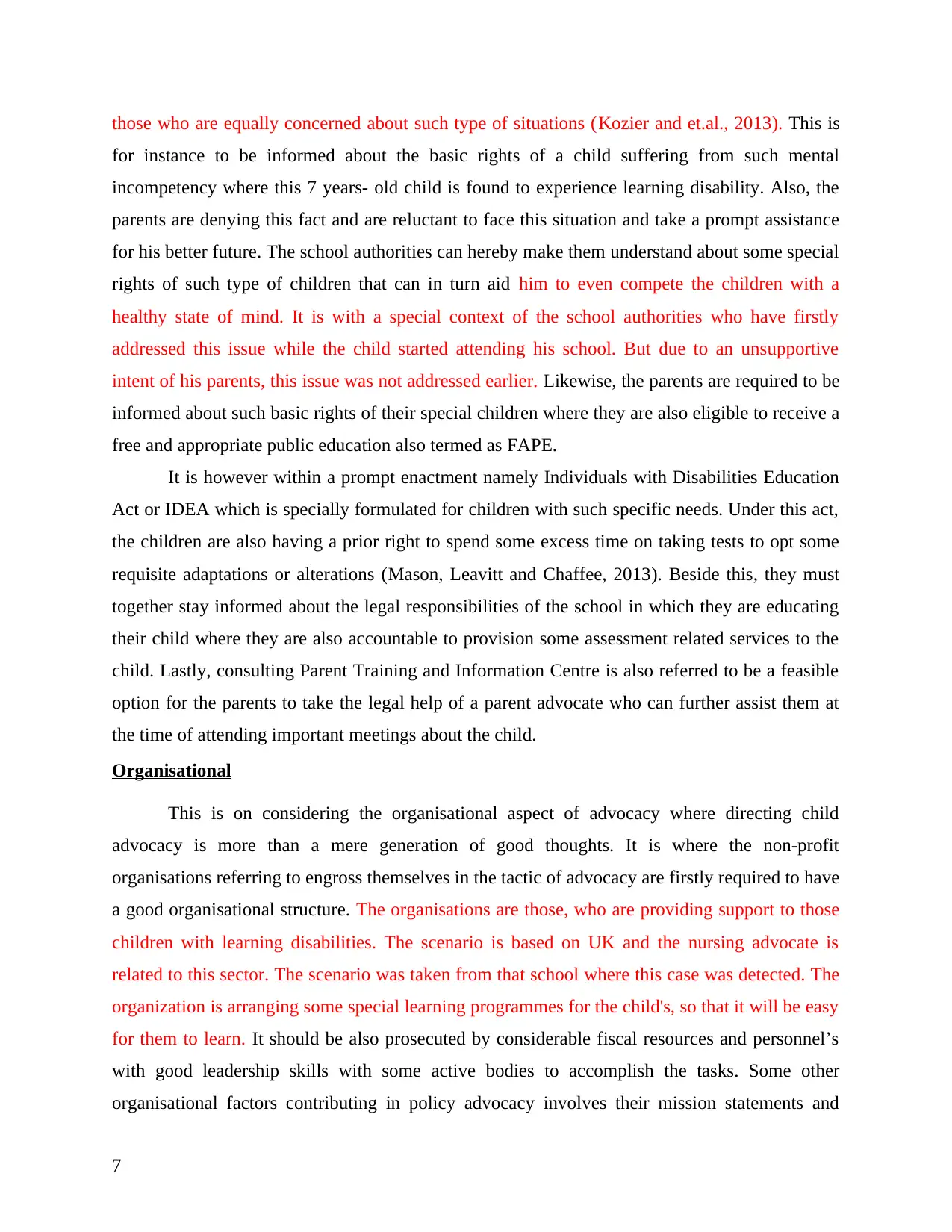
those who are equally concerned about such type of situations (Kozier and et.al., 2013). This is
for instance to be informed about the basic rights of a child suffering from such mental
incompetency where this 7 years- old child is found to experience learning disability. Also, the
parents are denying this fact and are reluctant to face this situation and take a prompt assistance
for his better future. The school authorities can hereby make them understand about some special
rights of such type of children that can in turn aid him to even compete the children with a
healthy state of mind. It is with a special context of the school authorities who have firstly
addressed this issue while the child started attending his school. But due to an unsupportive
intent of his parents, this issue was not addressed earlier. Likewise, the parents are required to be
informed about such basic rights of their special children where they are also eligible to receive a
free and appropriate public education also termed as FAPE.
It is however within a prompt enactment namely Individuals with Disabilities Education
Act or IDEA which is specially formulated for children with such specific needs. Under this act,
the children are also having a prior right to spend some excess time on taking tests to opt some
requisite adaptations or alterations (Mason, Leavitt and Chaffee, 2013). Beside this, they must
together stay informed about the legal responsibilities of the school in which they are educating
their child where they are also accountable to provision some assessment related services to the
child. Lastly, consulting Parent Training and Information Centre is also referred to be a feasible
option for the parents to take the legal help of a parent advocate who can further assist them at
the time of attending important meetings about the child.
Organisational
This is on considering the organisational aspect of advocacy where directing child
advocacy is more than a mere generation of good thoughts. It is where the non-profit
organisations referring to engross themselves in the tactic of advocacy are firstly required to have
a good organisational structure. The organisations are those, who are providing support to those
children with learning disabilities. The scenario is based on UK and the nursing advocate is
related to this sector. The scenario was taken from that school where this case was detected. The
organization is arranging some special learning programmes for the child's, so that it will be easy
for them to learn. It should be also prosecuted by considerable fiscal resources and personnel’s
with good leadership skills with some active bodies to accomplish the tasks. Some other
organisational factors contributing in policy advocacy involves their mission statements and
7
for instance to be informed about the basic rights of a child suffering from such mental
incompetency where this 7 years- old child is found to experience learning disability. Also, the
parents are denying this fact and are reluctant to face this situation and take a prompt assistance
for his better future. The school authorities can hereby make them understand about some special
rights of such type of children that can in turn aid him to even compete the children with a
healthy state of mind. It is with a special context of the school authorities who have firstly
addressed this issue while the child started attending his school. But due to an unsupportive
intent of his parents, this issue was not addressed earlier. Likewise, the parents are required to be
informed about such basic rights of their special children where they are also eligible to receive a
free and appropriate public education also termed as FAPE.
It is however within a prompt enactment namely Individuals with Disabilities Education
Act or IDEA which is specially formulated for children with such specific needs. Under this act,
the children are also having a prior right to spend some excess time on taking tests to opt some
requisite adaptations or alterations (Mason, Leavitt and Chaffee, 2013). Beside this, they must
together stay informed about the legal responsibilities of the school in which they are educating
their child where they are also accountable to provision some assessment related services to the
child. Lastly, consulting Parent Training and Information Centre is also referred to be a feasible
option for the parents to take the legal help of a parent advocate who can further assist them at
the time of attending important meetings about the child.
Organisational
This is on considering the organisational aspect of advocacy where directing child
advocacy is more than a mere generation of good thoughts. It is where the non-profit
organisations referring to engross themselves in the tactic of advocacy are firstly required to have
a good organisational structure. The organisations are those, who are providing support to those
children with learning disabilities. The scenario is based on UK and the nursing advocate is
related to this sector. The scenario was taken from that school where this case was detected. The
organization is arranging some special learning programmes for the child's, so that it will be easy
for them to learn. It should be also prosecuted by considerable fiscal resources and personnel’s
with good leadership skills with some active bodies to accomplish the tasks. Some other
organisational factors contributing in policy advocacy involves their mission statements and
7
Paraphrase This Document
Need a fresh take? Get an instant paraphrase of this document with our AI Paraphraser
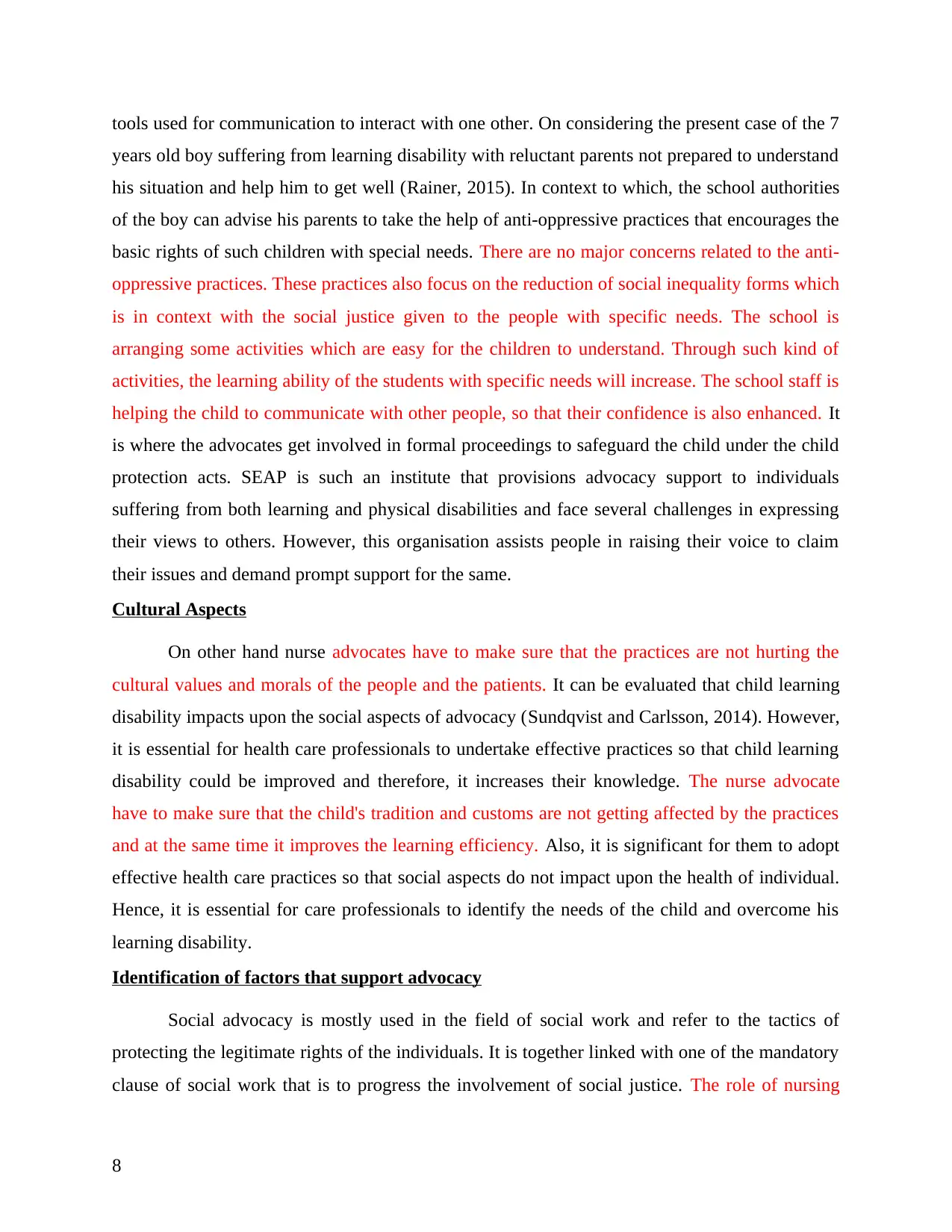
tools used for communication to interact with one other. On considering the present case of the 7
years old boy suffering from learning disability with reluctant parents not prepared to understand
his situation and help him to get well (Rainer, 2015). In context to which, the school authorities
of the boy can advise his parents to take the help of anti-oppressive practices that encourages the
basic rights of such children with special needs. There are no major concerns related to the anti-
oppressive practices. These practices also focus on the reduction of social inequality forms which
is in context with the social justice given to the people with specific needs. The school is
arranging some activities which are easy for the children to understand. Through such kind of
activities, the learning ability of the students with specific needs will increase. The school staff is
helping the child to communicate with other people, so that their confidence is also enhanced. It
is where the advocates get involved in formal proceedings to safeguard the child under the child
protection acts. SEAP is such an institute that provisions advocacy support to individuals
suffering from both learning and physical disabilities and face several challenges in expressing
their views to others. However, this organisation assists people in raising their voice to claim
their issues and demand prompt support for the same.
Cultural Aspects
On other hand nurse advocates have to make sure that the practices are not hurting the
cultural values and morals of the people and the patients. It can be evaluated that child learning
disability impacts upon the social aspects of advocacy (Sundqvist and Carlsson, 2014). However,
it is essential for health care professionals to undertake effective practices so that child learning
disability could be improved and therefore, it increases their knowledge. The nurse advocate
have to make sure that the child's tradition and customs are not getting affected by the practices
and at the same time it improves the learning efficiency. Also, it is significant for them to adopt
effective health care practices so that social aspects do not impact upon the health of individual.
Hence, it is essential for care professionals to identify the needs of the child and overcome his
learning disability.
Identification of factors that support advocacy
Social advocacy is mostly used in the field of social work and refer to the tactics of
protecting the legitimate rights of the individuals. It is together linked with one of the mandatory
clause of social work that is to progress the involvement of social justice. The role of nursing
8
years old boy suffering from learning disability with reluctant parents not prepared to understand
his situation and help him to get well (Rainer, 2015). In context to which, the school authorities
of the boy can advise his parents to take the help of anti-oppressive practices that encourages the
basic rights of such children with special needs. There are no major concerns related to the anti-
oppressive practices. These practices also focus on the reduction of social inequality forms which
is in context with the social justice given to the people with specific needs. The school is
arranging some activities which are easy for the children to understand. Through such kind of
activities, the learning ability of the students with specific needs will increase. The school staff is
helping the child to communicate with other people, so that their confidence is also enhanced. It
is where the advocates get involved in formal proceedings to safeguard the child under the child
protection acts. SEAP is such an institute that provisions advocacy support to individuals
suffering from both learning and physical disabilities and face several challenges in expressing
their views to others. However, this organisation assists people in raising their voice to claim
their issues and demand prompt support for the same.
Cultural Aspects
On other hand nurse advocates have to make sure that the practices are not hurting the
cultural values and morals of the people and the patients. It can be evaluated that child learning
disability impacts upon the social aspects of advocacy (Sundqvist and Carlsson, 2014). However,
it is essential for health care professionals to undertake effective practices so that child learning
disability could be improved and therefore, it increases their knowledge. The nurse advocate
have to make sure that the child's tradition and customs are not getting affected by the practices
and at the same time it improves the learning efficiency. Also, it is significant for them to adopt
effective health care practices so that social aspects do not impact upon the health of individual.
Hence, it is essential for care professionals to identify the needs of the child and overcome his
learning disability.
Identification of factors that support advocacy
Social advocacy is mostly used in the field of social work and refer to the tactics of
protecting the legitimate rights of the individuals. It is together linked with one of the mandatory
clause of social work that is to progress the involvement of social justice. The role of nursing
8
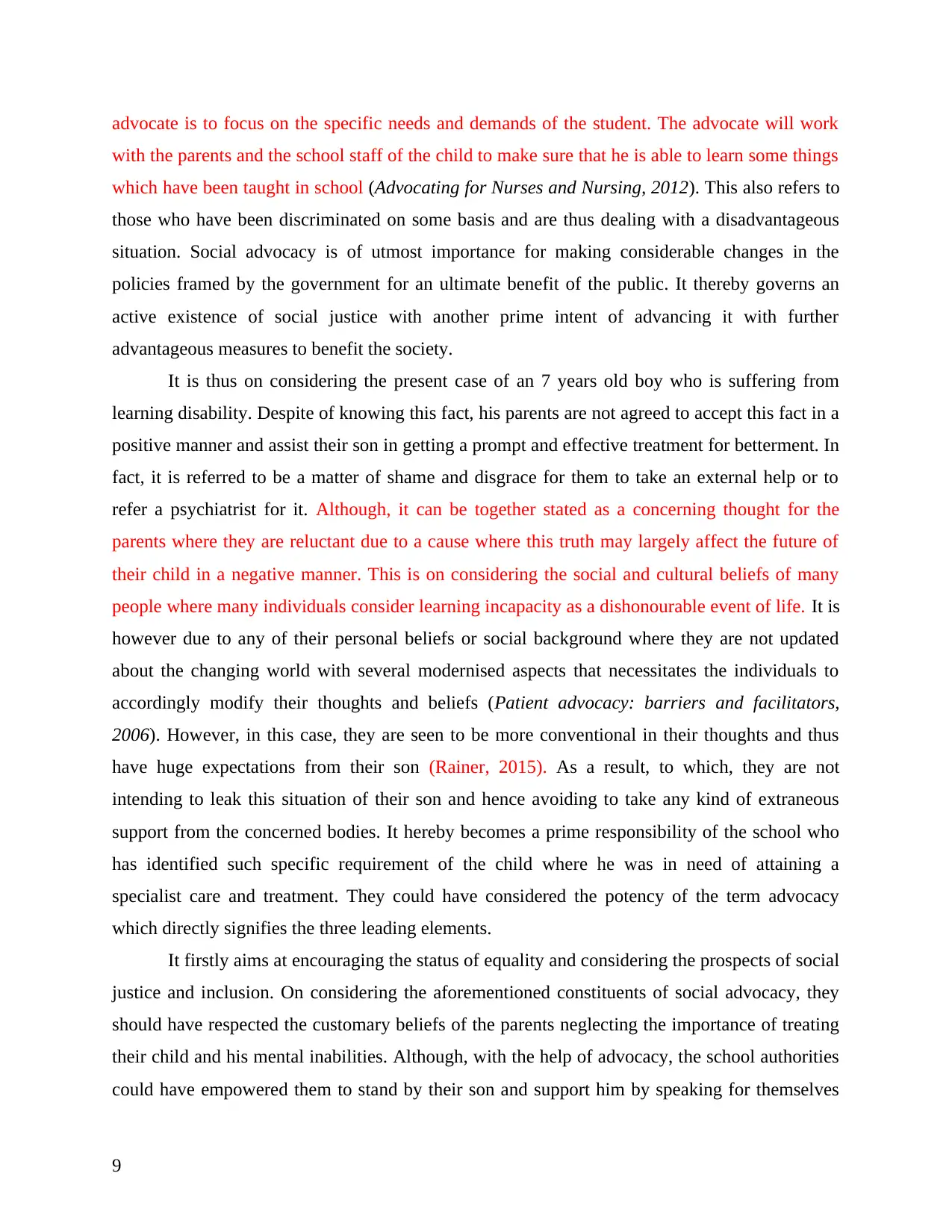
advocate is to focus on the specific needs and demands of the student. The advocate will work
with the parents and the school staff of the child to make sure that he is able to learn some things
which have been taught in school (Advocating for Nurses and Nursing, 2012). This also refers to
those who have been discriminated on some basis and are thus dealing with a disadvantageous
situation. Social advocacy is of utmost importance for making considerable changes in the
policies framed by the government for an ultimate benefit of the public. It thereby governs an
active existence of social justice with another prime intent of advancing it with further
advantageous measures to benefit the society.
It is thus on considering the present case of an 7 years old boy who is suffering from
learning disability. Despite of knowing this fact, his parents are not agreed to accept this fact in a
positive manner and assist their son in getting a prompt and effective treatment for betterment. In
fact, it is referred to be a matter of shame and disgrace for them to take an external help or to
refer a psychiatrist for it. Although, it can be together stated as a concerning thought for the
parents where they are reluctant due to a cause where this truth may largely affect the future of
their child in a negative manner. This is on considering the social and cultural beliefs of many
people where many individuals consider learning incapacity as a dishonourable event of life. It is
however due to any of their personal beliefs or social background where they are not updated
about the changing world with several modernised aspects that necessitates the individuals to
accordingly modify their thoughts and beliefs (Patient advocacy: barriers and facilitators,
2006). However, in this case, they are seen to be more conventional in their thoughts and thus
have huge expectations from their son (Rainer, 2015). As a result, to which, they are not
intending to leak this situation of their son and hence avoiding to take any kind of extraneous
support from the concerned bodies. It hereby becomes a prime responsibility of the school who
has identified such specific requirement of the child where he was in need of attaining a
specialist care and treatment. They could have considered the potency of the term advocacy
which directly signifies the three leading elements.
It firstly aims at encouraging the status of equality and considering the prospects of social
justice and inclusion. On considering the aforementioned constituents of social advocacy, they
should have respected the customary beliefs of the parents neglecting the importance of treating
their child and his mental inabilities. Although, with the help of advocacy, the school authorities
could have empowered them to stand by their son and support him by speaking for themselves
9
with the parents and the school staff of the child to make sure that he is able to learn some things
which have been taught in school (Advocating for Nurses and Nursing, 2012). This also refers to
those who have been discriminated on some basis and are thus dealing with a disadvantageous
situation. Social advocacy is of utmost importance for making considerable changes in the
policies framed by the government for an ultimate benefit of the public. It thereby governs an
active existence of social justice with another prime intent of advancing it with further
advantageous measures to benefit the society.
It is thus on considering the present case of an 7 years old boy who is suffering from
learning disability. Despite of knowing this fact, his parents are not agreed to accept this fact in a
positive manner and assist their son in getting a prompt and effective treatment for betterment. In
fact, it is referred to be a matter of shame and disgrace for them to take an external help or to
refer a psychiatrist for it. Although, it can be together stated as a concerning thought for the
parents where they are reluctant due to a cause where this truth may largely affect the future of
their child in a negative manner. This is on considering the social and cultural beliefs of many
people where many individuals consider learning incapacity as a dishonourable event of life. It is
however due to any of their personal beliefs or social background where they are not updated
about the changing world with several modernised aspects that necessitates the individuals to
accordingly modify their thoughts and beliefs (Patient advocacy: barriers and facilitators,
2006). However, in this case, they are seen to be more conventional in their thoughts and thus
have huge expectations from their son (Rainer, 2015). As a result, to which, they are not
intending to leak this situation of their son and hence avoiding to take any kind of extraneous
support from the concerned bodies. It hereby becomes a prime responsibility of the school who
has identified such specific requirement of the child where he was in need of attaining a
specialist care and treatment. They could have considered the potency of the term advocacy
which directly signifies the three leading elements.
It firstly aims at encouraging the status of equality and considering the prospects of social
justice and inclusion. On considering the aforementioned constituents of social advocacy, they
should have respected the customary beliefs of the parents neglecting the importance of treating
their child and his mental inabilities. Although, with the help of advocacy, the school authorities
could have empowered them to stand by their son and support him by speaking for themselves
9
⊘ This is a preview!⊘
Do you want full access?
Subscribe today to unlock all pages.

Trusted by 1+ million students worldwide
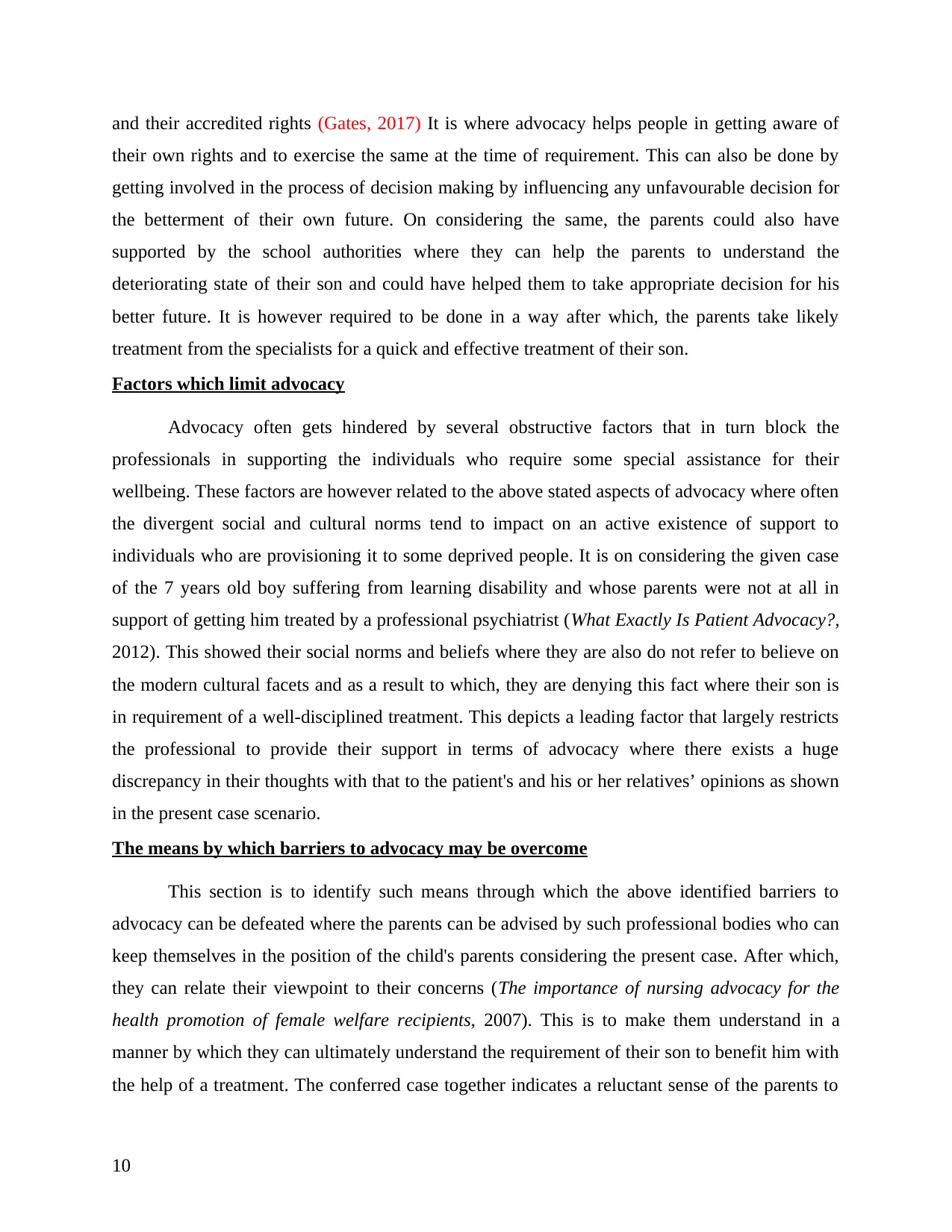
and their accredited rights (Gates, 2017) It is where advocacy helps people in getting aware of
their own rights and to exercise the same at the time of requirement. This can also be done by
getting involved in the process of decision making by influencing any unfavourable decision for
the betterment of their own future. On considering the same, the parents could also have
supported by the school authorities where they can help the parents to understand the
deteriorating state of their son and could have helped them to take appropriate decision for his
better future. It is however required to be done in a way after which, the parents take likely
treatment from the specialists for a quick and effective treatment of their son.
Factors which limit advocacy
Advocacy often gets hindered by several obstructive factors that in turn block the
professionals in supporting the individuals who require some special assistance for their
wellbeing. These factors are however related to the above stated aspects of advocacy where often
the divergent social and cultural norms tend to impact on an active existence of support to
individuals who are provisioning it to some deprived people. It is on considering the given case
of the 7 years old boy suffering from learning disability and whose parents were not at all in
support of getting him treated by a professional psychiatrist (What Exactly Is Patient Advocacy?,
2012). This showed their social norms and beliefs where they are also do not refer to believe on
the modern cultural facets and as a result to which, they are denying this fact where their son is
in requirement of a well-disciplined treatment. This depicts a leading factor that largely restricts
the professional to provide their support in terms of advocacy where there exists a huge
discrepancy in their thoughts with that to the patient's and his or her relatives’ opinions as shown
in the present case scenario.
The means by which barriers to advocacy may be overcome
This section is to identify such means through which the above identified barriers to
advocacy can be defeated where the parents can be advised by such professional bodies who can
keep themselves in the position of the child's parents considering the present case. After which,
they can relate their viewpoint to their concerns (The importance of nursing advocacy for the
health promotion of female welfare recipients, 2007). This is to make them understand in a
manner by which they can ultimately understand the requirement of their son to benefit him with
the help of a treatment. The conferred case together indicates a reluctant sense of the parents to
10
their own rights and to exercise the same at the time of requirement. This can also be done by
getting involved in the process of decision making by influencing any unfavourable decision for
the betterment of their own future. On considering the same, the parents could also have
supported by the school authorities where they can help the parents to understand the
deteriorating state of their son and could have helped them to take appropriate decision for his
better future. It is however required to be done in a way after which, the parents take likely
treatment from the specialists for a quick and effective treatment of their son.
Factors which limit advocacy
Advocacy often gets hindered by several obstructive factors that in turn block the
professionals in supporting the individuals who require some special assistance for their
wellbeing. These factors are however related to the above stated aspects of advocacy where often
the divergent social and cultural norms tend to impact on an active existence of support to
individuals who are provisioning it to some deprived people. It is on considering the given case
of the 7 years old boy suffering from learning disability and whose parents were not at all in
support of getting him treated by a professional psychiatrist (What Exactly Is Patient Advocacy?,
2012). This showed their social norms and beliefs where they are also do not refer to believe on
the modern cultural facets and as a result to which, they are denying this fact where their son is
in requirement of a well-disciplined treatment. This depicts a leading factor that largely restricts
the professional to provide their support in terms of advocacy where there exists a huge
discrepancy in their thoughts with that to the patient's and his or her relatives’ opinions as shown
in the present case scenario.
The means by which barriers to advocacy may be overcome
This section is to identify such means through which the above identified barriers to
advocacy can be defeated where the parents can be advised by such professional bodies who can
keep themselves in the position of the child's parents considering the present case. After which,
they can relate their viewpoint to their concerns (The importance of nursing advocacy for the
health promotion of female welfare recipients, 2007). This is to make them understand in a
manner by which they can ultimately understand the requirement of their son to benefit him with
the help of a treatment. The conferred case together indicates a reluctant sense of the parents to
10
Paraphrase This Document
Need a fresh take? Get an instant paraphrase of this document with our AI Paraphraser
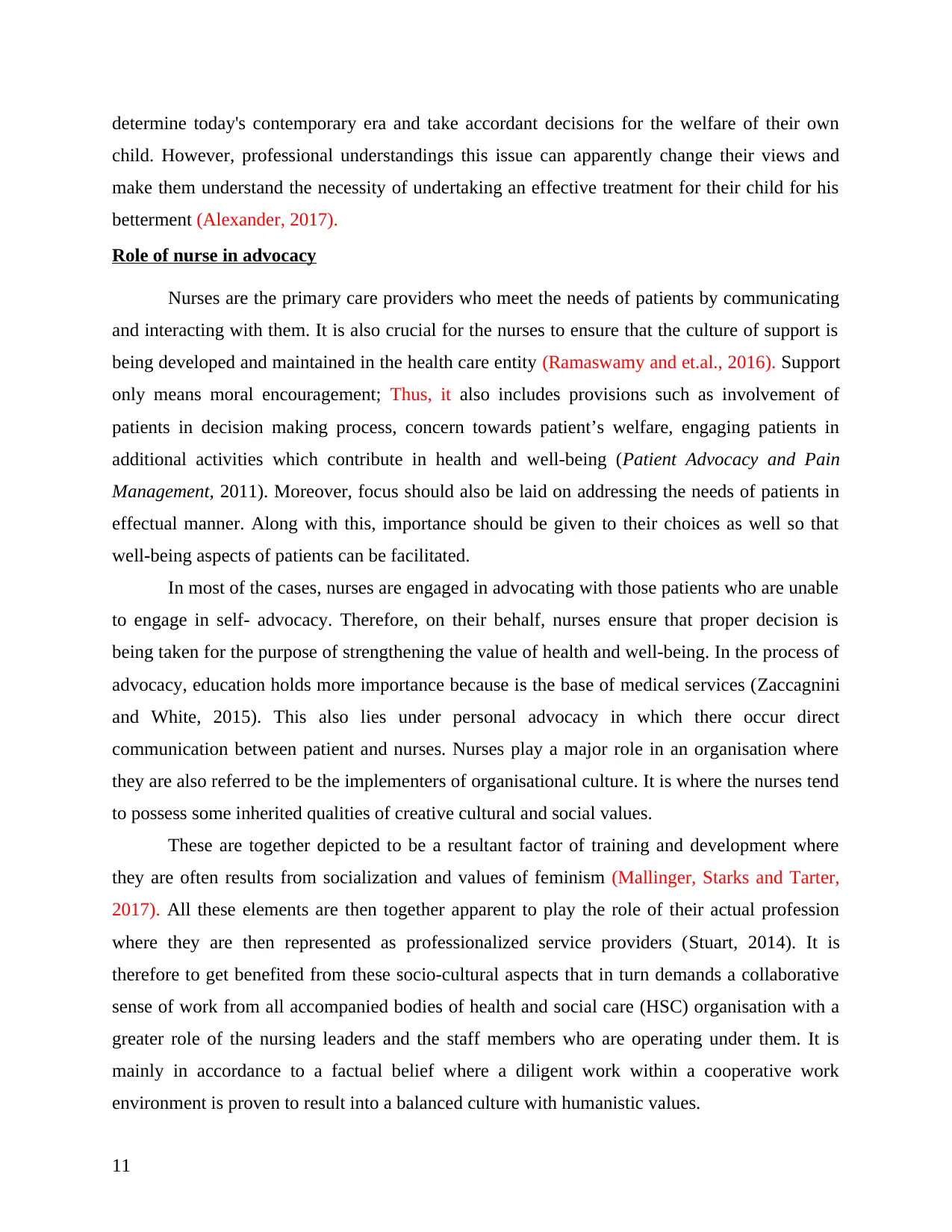
determine today's contemporary era and take accordant decisions for the welfare of their own
child. However, professional understandings this issue can apparently change their views and
make them understand the necessity of undertaking an effective treatment for their child for his
betterment (Alexander, 2017).
Role of nurse in advocacy
Nurses are the primary care providers who meet the needs of patients by communicating
and interacting with them. It is also crucial for the nurses to ensure that the culture of support is
being developed and maintained in the health care entity (Ramaswamy and et.al., 2016). Support
only means moral encouragement; Thus, it also includes provisions such as involvement of
patients in decision making process, concern towards patient’s welfare, engaging patients in
additional activities which contribute in health and well-being (Patient Advocacy and Pain
Management, 2011). Moreover, focus should also be laid on addressing the needs of patients in
effectual manner. Along with this, importance should be given to their choices as well so that
well-being aspects of patients can be facilitated.
In most of the cases, nurses are engaged in advocating with those patients who are unable
to engage in self- advocacy. Therefore, on their behalf, nurses ensure that proper decision is
being taken for the purpose of strengthening the value of health and well-being. In the process of
advocacy, education holds more importance because is the base of medical services (Zaccagnini
and White, 2015). This also lies under personal advocacy in which there occur direct
communication between patient and nurses. Nurses play a major role in an organisation where
they are also referred to be the implementers of organisational culture. It is where the nurses tend
to possess some inherited qualities of creative cultural and social values.
These are together depicted to be a resultant factor of training and development where
they are often results from socialization and values of feminism (Mallinger, Starks and Tarter,
2017). All these elements are then together apparent to play the role of their actual profession
where they are then represented as professionalized service providers (Stuart, 2014). It is
therefore to get benefited from these socio-cultural aspects that in turn demands a collaborative
sense of work from all accompanied bodies of health and social care (HSC) organisation with a
greater role of the nursing leaders and the staff members who are operating under them. It is
mainly in accordance to a factual belief where a diligent work within a cooperative work
environment is proven to result into a balanced culture with humanistic values.
11
child. However, professional understandings this issue can apparently change their views and
make them understand the necessity of undertaking an effective treatment for their child for his
betterment (Alexander, 2017).
Role of nurse in advocacy
Nurses are the primary care providers who meet the needs of patients by communicating
and interacting with them. It is also crucial for the nurses to ensure that the culture of support is
being developed and maintained in the health care entity (Ramaswamy and et.al., 2016). Support
only means moral encouragement; Thus, it also includes provisions such as involvement of
patients in decision making process, concern towards patient’s welfare, engaging patients in
additional activities which contribute in health and well-being (Patient Advocacy and Pain
Management, 2011). Moreover, focus should also be laid on addressing the needs of patients in
effectual manner. Along with this, importance should be given to their choices as well so that
well-being aspects of patients can be facilitated.
In most of the cases, nurses are engaged in advocating with those patients who are unable
to engage in self- advocacy. Therefore, on their behalf, nurses ensure that proper decision is
being taken for the purpose of strengthening the value of health and well-being. In the process of
advocacy, education holds more importance because is the base of medical services (Zaccagnini
and White, 2015). This also lies under personal advocacy in which there occur direct
communication between patient and nurses. Nurses play a major role in an organisation where
they are also referred to be the implementers of organisational culture. It is where the nurses tend
to possess some inherited qualities of creative cultural and social values.
These are together depicted to be a resultant factor of training and development where
they are often results from socialization and values of feminism (Mallinger, Starks and Tarter,
2017). All these elements are then together apparent to play the role of their actual profession
where they are then represented as professionalized service providers (Stuart, 2014). It is
therefore to get benefited from these socio-cultural aspects that in turn demands a collaborative
sense of work from all accompanied bodies of health and social care (HSC) organisation with a
greater role of the nursing leaders and the staff members who are operating under them. It is
mainly in accordance to a factual belief where a diligent work within a cooperative work
environment is proven to result into a balanced culture with humanistic values.
11
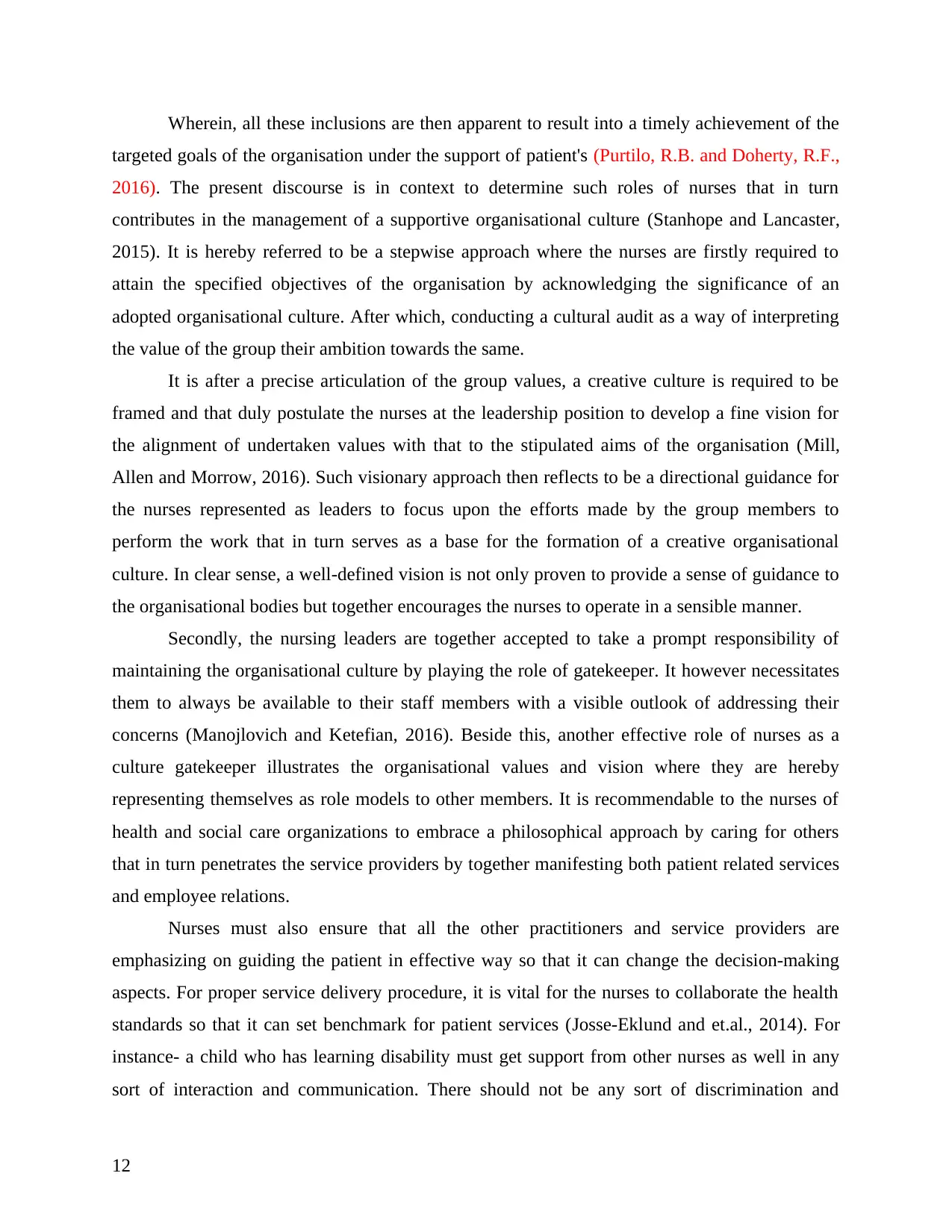
Wherein, all these inclusions are then apparent to result into a timely achievement of the
targeted goals of the organisation under the support of patient's (Purtilo, R.B. and Doherty, R.F.,
2016). The present discourse is in context to determine such roles of nurses that in turn
contributes in the management of a supportive organisational culture (Stanhope and Lancaster,
2015). It is hereby referred to be a stepwise approach where the nurses are firstly required to
attain the specified objectives of the organisation by acknowledging the significance of an
adopted organisational culture. After which, conducting a cultural audit as a way of interpreting
the value of the group their ambition towards the same.
It is after a precise articulation of the group values, a creative culture is required to be
framed and that duly postulate the nurses at the leadership position to develop a fine vision for
the alignment of undertaken values with that to the stipulated aims of the organisation (Mill,
Allen and Morrow, 2016). Such visionary approach then reflects to be a directional guidance for
the nurses represented as leaders to focus upon the efforts made by the group members to
perform the work that in turn serves as a base for the formation of a creative organisational
culture. In clear sense, a well-defined vision is not only proven to provide a sense of guidance to
the organisational bodies but together encourages the nurses to operate in a sensible manner.
Secondly, the nursing leaders are together accepted to take a prompt responsibility of
maintaining the organisational culture by playing the role of gatekeeper. It however necessitates
them to always be available to their staff members with a visible outlook of addressing their
concerns (Manojlovich and Ketefian, 2016). Beside this, another effective role of nurses as a
culture gatekeeper illustrates the organisational values and vision where they are hereby
representing themselves as role models to other members. It is recommendable to the nurses of
health and social care organizations to embrace a philosophical approach by caring for others
that in turn penetrates the service providers by together manifesting both patient related services
and employee relations.
Nurses must also ensure that all the other practitioners and service providers are
emphasizing on guiding the patient in effective way so that it can change the decision-making
aspects. For proper service delivery procedure, it is vital for the nurses to collaborate the health
standards so that it can set benchmark for patient services (Josse-Eklund and et.al., 2014). For
instance- a child who has learning disability must get support from other nurses as well in any
sort of interaction and communication. There should not be any sort of discrimination and
12
targeted goals of the organisation under the support of patient's (Purtilo, R.B. and Doherty, R.F.,
2016). The present discourse is in context to determine such roles of nurses that in turn
contributes in the management of a supportive organisational culture (Stanhope and Lancaster,
2015). It is hereby referred to be a stepwise approach where the nurses are firstly required to
attain the specified objectives of the organisation by acknowledging the significance of an
adopted organisational culture. After which, conducting a cultural audit as a way of interpreting
the value of the group their ambition towards the same.
It is after a precise articulation of the group values, a creative culture is required to be
framed and that duly postulate the nurses at the leadership position to develop a fine vision for
the alignment of undertaken values with that to the stipulated aims of the organisation (Mill,
Allen and Morrow, 2016). Such visionary approach then reflects to be a directional guidance for
the nurses represented as leaders to focus upon the efforts made by the group members to
perform the work that in turn serves as a base for the formation of a creative organisational
culture. In clear sense, a well-defined vision is not only proven to provide a sense of guidance to
the organisational bodies but together encourages the nurses to operate in a sensible manner.
Secondly, the nursing leaders are together accepted to take a prompt responsibility of
maintaining the organisational culture by playing the role of gatekeeper. It however necessitates
them to always be available to their staff members with a visible outlook of addressing their
concerns (Manojlovich and Ketefian, 2016). Beside this, another effective role of nurses as a
culture gatekeeper illustrates the organisational values and vision where they are hereby
representing themselves as role models to other members. It is recommendable to the nurses of
health and social care organizations to embrace a philosophical approach by caring for others
that in turn penetrates the service providers by together manifesting both patient related services
and employee relations.
Nurses must also ensure that all the other practitioners and service providers are
emphasizing on guiding the patient in effective way so that it can change the decision-making
aspects. For proper service delivery procedure, it is vital for the nurses to collaborate the health
standards so that it can set benchmark for patient services (Josse-Eklund and et.al., 2014). For
instance- a child who has learning disability must get support from other nurses as well in any
sort of interaction and communication. There should not be any sort of discrimination and
12
⊘ This is a preview!⊘
Do you want full access?
Subscribe today to unlock all pages.

Trusted by 1+ million students worldwide
1 out of 19
Related Documents
Your All-in-One AI-Powered Toolkit for Academic Success.
+13062052269
info@desklib.com
Available 24*7 on WhatsApp / Email
![[object Object]](/_next/static/media/star-bottom.7253800d.svg)
Unlock your academic potential
Copyright © 2020–2025 A2Z Services. All Rights Reserved. Developed and managed by ZUCOL.





